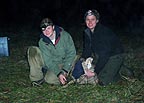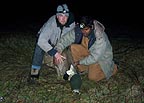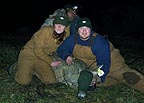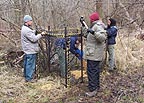February 02, 2006
Scientists study deer behavior in central Illinois
CARBONDALE, Ill. -- Scientists at Southern Illinois University Carbondale are using satellites to study the social lives of whitetail deer living in the expansive open spaces of central Illinois, with the goal of learning more about the potential spread of a neurological disease affecting deer in the northern part of the state.
Working through a five-year, $700,000 federal wildlife grant administered by the Illinois Department of Natural Resources, the team is trapping and tagging deer with satellite and radio tracking units. The tags allow the scientists to examine the deer's movements, distribution and contact with each other.
Eric M. Schauber and Clay Nielsen, scientists with SIUC's Cooperative Wildlife Research Laboratory, are looking at the potential for disease transmission among deer populating the vast agricultural areas and sparse cover prevalent in Moultrie County. They are conducting research on land operated by U.S. Army Corps of Engineers and the Shelbyville State Fish & Wildlife Area, near Lake Shelbyville.
The research could affect the approach wildlife managers take in controlling communicable ailments such as chronic wasting disease, which has been observed in deer in northern Illinois.
Chronic wasting disease, or CWD, has been around since the 1960s. Deer infected with CWD stop eating, waste away and eventually die. Scientists traditionally thought CWD existed only in deer and elk in the Western United States, but researchers discovered it had spread to other states in recent years. In 2002, wildlife officials discovered infected deer in Wisconsin and northern Illinois.
"Chronic wasting disease has only recently come to the attention of wildlife managers, maybe within the last five or six years," said Schauber, assistant professor of zoology at SIUC. "It's become a hot button because it affects animals people care about – deer, and elk out West.
"We want to know what CWD is going to do to the deer population and health," he said. "The state is checking it in northern Illinois and it doesn't seem to be spreading rapidly, which is good. But we'd like to know how rapidly it could spread."
To that end, the team hopes to trap and tag about 60 whitetail deer each year for the next three years. Several members of the team working out of a doublewide trailer in Sullivan are venturing into the woods and fields each day laying out bait and springing traps.
The team uses drop nets, "rocket nets" that can be fired over the top of the animal and metal-framed stalls that close behind the deer after they enter to eat the corn and apple bait. When they trap one, the researchers move in quickly to subdue, blindfold and sedate the animal before it can injure itself or one of them. They next attach a tag – a neck collar for females and ear tag for males – and take a few notes before releasing the animal.
The team will fit most of the deer with a standard radio tag transmitting a VHF signal that they'll track and triangulate to give a position. During the next few years, however, they will fit at least 34 animals with tags that both transmit the VHF signal and contain a global positioning satellite unit that uses orbiting spacecraft to record its near-exact position – within 10 yards – every two hours.
The team programmed the GPS units, which cost about $3,000 new, to drop off the deer after 18 months. Researchers will then track them down using the VHF signal and recover the data inside. A contractor then "refurbishes" the unit for about half the original price and researchers send it back out into the field on another deer.
The mild winter, however, so far has allowed the deer to be more selective in their feeding habits, diminishing the effectiveness of the traps. As of late January, they had managed to capture and tag only a handful.
Schauber, whose interests include wildlife disease and predator-prey interactions, hopes to use the GPS data to study how often deer come into contact with one another directly, and how often they visit the same area. Such data can be important when studying CWD as it relates to deer potentially coming into contact with infected deer or body fluids such as saliva or urine.
"That's one of the things that is unique about our study," Schauber said. "Researchers have used GPS to track animals. But no one has used them to study contact with other animals."
The GPS units also will help measure how far young deer disperse from their birthplace once they are grown. Schauber said evidence suggest deer in sparsely wooded areas tend to go farther away, thus possibly increasing the pace of disease spread.
Both the radio and radio-GPS units include telephone numbers and other information instructing anyone who kills the deer wearing it to contact SIUC. The mortality rate of such deer is part of the study, too.
The money funding the study comes from the federal wildlife restoration budget, which hunters pay on hunting equipment purchases.
Leading in research, scholarly and creative activities is among the goals of Southern at 150: Building Excellence Through Commitment, the blueprint the University is following as it approaches its 150th anniversary in 2019.

Safety first – Gail
Morris, left, of Williamsport,
Pa., and Stacey Lindemann,
of Shelbyville, Ill., members
of a team of researchers
from Southern Illinois
University Carbondale,
prepare to release a deer
they helped capture and tag
in late January in central
Illinois. The team hopes to
capture, tag and release about
120 animals during the next
three years to study the
potential for disease spread
among deer populating the
heavily agricultural, sparsely
wooded areas of central Illinois.
Download Photo Here

Safety first – Marc Conlee,
left, and Viraj Perera, members
of a team of researchers from
Southern Illinois University
Carbondale, prepare to release a
deer they helped capture and tag
in late January in central
Illinois. The team hopes to
capture, tag and release about 120
animals during the next three years
to study the potential for disease
spread among deer populating the
heavily agricultural, sparsely
wooded areas of central Illinois.
Download Photo Here

Safety first – Lene Kjaer,
left, Viraj Perera, center, and
Charles Anderson, of Morrison,
Ill., members of a team of
researchers from Southern
Illinois University Carbondale,
prepare to release a deer they
helped capture and tag in late
January in central Illinois. The
team hopes to capture, tag and
release about 120 animals during
the next three years to study
the potential for disease spread
among deer populating the heavily
agricultural, sparsely wooded areas
of central Illinois. Download
Photo Here

Setting up – Members of
a team of researchers from
Southern Illinois University
Carbondale set up a metal-
framed trap for whitetail
deer in Moultrie County. The
team hopes to capture, tag
and release about 120 animals
during the next three years
to study the potential for
disease spread among deer
populating the heavily
agricultural, sparsely wooded
areas of central Illinois.
Download Photo Here
